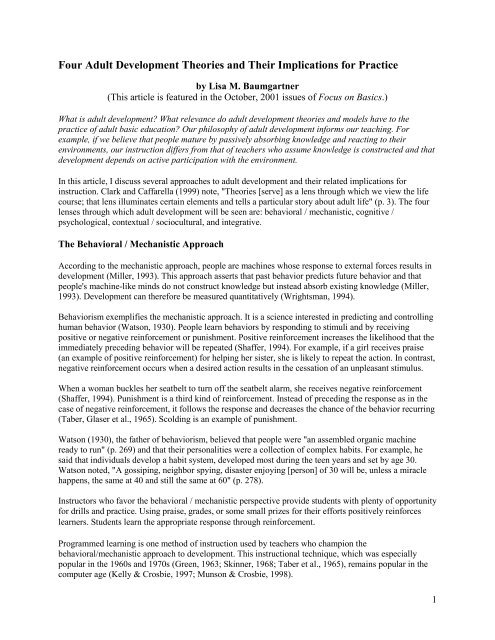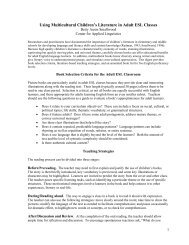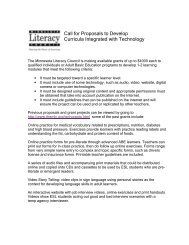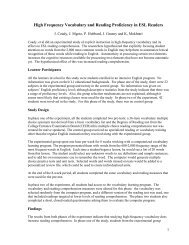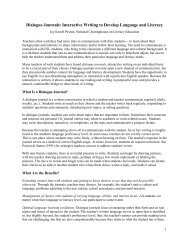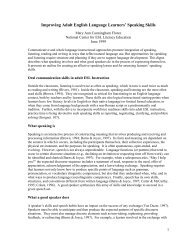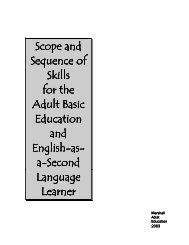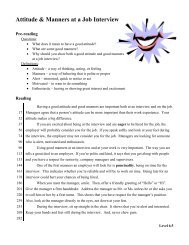Four Adult Development Theories and Their Implications for Practice
Four Adult Development Theories and Their Implications for Practice
Four Adult Development Theories and Their Implications for Practice
You also want an ePaper? Increase the reach of your titles
YUMPU automatically turns print PDFs into web optimized ePapers that Google loves.
<strong>Four</strong> <strong>Adult</strong> <strong>Development</strong> <strong>Theories</strong> <strong>and</strong> <strong>Their</strong> <strong>Implications</strong> <strong>for</strong> <strong>Practice</strong><br />
by Lisa M. Baumgartner<br />
(This article is featured in the October, 2001 issues of Focus on Basics.)<br />
What is adult development What relevance do adult development theories <strong>and</strong> models have to the<br />
practice of adult basic education Our philosophy of adult development in<strong>for</strong>ms our teaching. For<br />
example, if we believe that people mature by passively absorbing knowledge <strong>and</strong> reacting to their<br />
environments, our instruction differs from that of teachers who assume knowledge is constructed <strong>and</strong> that<br />
development depends on active participation with the environment.<br />
In this article, I discuss several approaches to adult development <strong>and</strong> their related implications <strong>for</strong><br />
instruction. Clark <strong>and</strong> Caffarella (1999) note, "<strong>Theories</strong> [serve] as a lens through which we view the life<br />
course; that lens illuminates certain elements <strong>and</strong> tells a particular story about adult life" (p. 3). The four<br />
lenses through which adult development will be seen are: behavioral / mechanistic, cognitive /<br />
psychological, contextual / sociocultural, <strong>and</strong> integrative.<br />
The Behavioral / Mechanistic Approach<br />
According to the mechanistic approach, people are machines whose response to external <strong>for</strong>ces results in<br />
development (Miller, 1993). This approach asserts that past behavior predicts future behavior <strong>and</strong> that<br />
people's machine-like minds do not construct knowledge but instead absorb existing knowledge (Miller,<br />
1993). <strong>Development</strong> can there<strong>for</strong>e be measured quantitatively (Wrightsman, 1994).<br />
Behaviorism exemplifies the mechanistic approach. It is a science interested in predicting <strong>and</strong> controlling<br />
human behavior (Watson, 1930). People learn behaviors by responding to stimuli <strong>and</strong> by receiving<br />
positive or negative rein<strong>for</strong>cement or punishment. Positive rein<strong>for</strong>cement increases the likelihood that the<br />
immediately preceding behavior will be repeated (Shaffer, 1994). For example, if a girl receives praise<br />
(an example of positive rein<strong>for</strong>cement) <strong>for</strong> helping her sister, she is likely to repeat the action. In contrast,<br />
negative rein<strong>for</strong>cement occurs when a desired action results in the cessation of an unpleasant stimulus.<br />
When a woman buckles her seatbelt to turn off the seatbelt alarm, she receives negative rein<strong>for</strong>cement<br />
(Shaffer, 1994). Punishment is a third kind of rein<strong>for</strong>cement. Instead of preceding the response as in the<br />
case of negative rein<strong>for</strong>cement, it follows the response <strong>and</strong> decreases the chance of the behavior recurring<br />
(Taber, Glaser et al., 1965). Scolding is an example of punishment.<br />
Watson (1930), the father of behaviorism, believed that people were "an assembled organic machine<br />
ready to run" (p. 269) <strong>and</strong> that their personalities were a collection of complex habits. For example, he<br />
said that individuals develop a habit system, developed most during the teen years <strong>and</strong> set by age 30.<br />
Watson noted, "A gossiping, neighbor spying, disaster enjoying [person] of 30 will be, unless a miracle<br />
happens, the same at 40 <strong>and</strong> still the same at 60" (p. 278).<br />
Instructors who favor the behavioral / mechanistic perspective provide students with plenty of opportunity<br />
<strong>for</strong> drills <strong>and</strong> practice. Using praise, grades, or some small prizes <strong>for</strong> their ef<strong>for</strong>ts positively rein<strong>for</strong>ces<br />
learners. Students learn the appropriate response through rein<strong>for</strong>cement.<br />
Programmed learning is one method of instruction used by teachers who champion the<br />
behavioral/mechanistic approach to development. This instructional technique, which was especially<br />
popular in the 1960s <strong>and</strong> 1970s (Green, 1963; Skinner, 1968; Taber et al., 1965), remains popular in the<br />
computer age (Kelly & Crosbie, 1997; Munson & Crosbie, 1998).<br />
1
Programmed learning involves assessing a student's prior knowledge about a topic, then basing individual<br />
programs of instruction on the student's level of expertise, <strong>and</strong> leading a student through a program of<br />
instruction via a book, slides, or a computer program. The material is divided into manageable portions<br />
called frames (Taber et al., 1965). After each frame, a question is asked <strong>and</strong> the student responds <strong>and</strong><br />
receives immediate feedback. For example, learners in a research methods course may be presented with<br />
the explanation of a particular experimental research design. Next, they are asked a question about the<br />
in<strong>for</strong>mation in the frame. After a correct response, the computer program may respond "Great job!" An<br />
incorrect response may yield, "Nice try, but try again." This rein<strong>for</strong>cement results in retention of the<br />
in<strong>for</strong>mation.<br />
The teacher who embraces this paradigm sees development as correct behavioral responses. People's<br />
personalities are a series of habits <strong>and</strong> the teacher's job is to get the student to develop good habits.<br />
Learning is additive in nature. Each set of facts builds on previous knowledge <strong>and</strong> this addition of<br />
knowledge can be accomplished with various types of rein<strong>for</strong>cement.<br />
The Psychological / Cognitive Approach<br />
The psychological / cognitive perspective focuses on an individual's "internal developmental processes"<br />
in interaction with the environment (Clark & Caffarella, 1999, p. 5). Clark <strong>and</strong> Caffarella differentiate<br />
between sequential models of development <strong>and</strong> models based on life events or transitions (p. 5).<br />
Sequential models, also called stage or phase models, assume that development is unidirectional in nature,<br />
that present development is build on past development, <strong>and</strong> that there is an endpoint (Miller, 1993). In the<br />
life event or transition model humans are active participants in their development, actively constructing<br />
knowledge rather than simply absorbing it. For example, a chronically ill woman changes medication <strong>and</strong><br />
becomes increasingly lethargic. She learns more about the new drug's side effects from friends, health<br />
professionals, <strong>and</strong> the Internet. She notices that when she eats certain foods in combination with the drug,<br />
it increases her fatigue. Her knowledge <strong>and</strong> personal experience help her realize she must change her diet<br />
to alleviate the lethargy.<br />
One psychological / cognitive approach examines life events <strong>and</strong> transitions. Pearlin's (1982) model notes<br />
that anticipated life course role changes, such as getting married <strong>and</strong> having children, cause less<br />
psychological distress than unscheduled changes such as car accidents or the loss of employment. Pearlin<br />
maintains that social class, a person's coping skills, the social support networks available to a person, <strong>and</strong><br />
the type of stress all have an impact on the individual route that a person's life course follows (Bee &<br />
Bjorkl<strong>and</strong>, 2000).<br />
The psychological / cognitive approach to development asserts that people reach more complex,<br />
integrated levels of development through active participation with their environment. Furthermore,<br />
individuals construct knowledge as opposed to responding to existing knowledge. In essence, adult<br />
development is a continuous journey toward increasingly complex levels of development. Hence, teachers<br />
taking this perspective favor ideas found in the trans<strong>for</strong>mational learning literature, such as critical<br />
reflection <strong>and</strong> discussion (Daloz, 1999; Mezirow, 1991).<br />
Mezirow (1990) asserts that through reflection, individuals often arrive at an "a more inclusive,<br />
differentiated, permeable <strong>and</strong> integrated perspective" (p. 14). To encourage critical reflection,<br />
instructors may have people engage in role plays. Role reversal activities help learners to explore <strong>and</strong><br />
express views other than their own, which could encourage them to broaden their perspectives (Cranton,<br />
1994). Another technique involves a method of journal writing, in which learners use one side of the page<br />
<strong>for</strong> observation <strong>and</strong> descriptions <strong>and</strong> the other side <strong>for</strong> thoughts, feelings, related experiences, or images<br />
provoked by the description (Cranton, 1994, p. 179).<br />
2
Mezirow (1991) maintains that discussion with others is integral to adult learning <strong>and</strong> development.<br />
Instructors who champion the psychological / cognitive view provide discussion guidelines (Cranton,<br />
1994) that ensure an atmosphere of trust, safety, <strong>and</strong> respect in which learners felt com<strong>for</strong>table expressing<br />
their ideas. Instructors also allow <strong>for</strong> quiet time in the discussion groups.<br />
Lastly, teachers recognize that learners' receptiveness to in<strong>for</strong>mation may be based on their life stage or<br />
time of transition. People often return to the classroom during a time of transition (Daloz, 1986; 1999).<br />
Instructors holding the psychological / cognitive view watch <strong>for</strong> what Havinghurst (1972) has termed<br />
"teachable moments," in which people are ready to learn <strong>and</strong> apply a concept because of their life<br />
situation.<br />
Teachers who champion the psychological / cognitive framework believe that knowledge is constructed<br />
<strong>and</strong> that adults are active participants in their development. Instructors encourage critical reflection <strong>and</strong><br />
discussion through a variety of activities. They realize that learners often return to school during a time of<br />
transition <strong>and</strong> look <strong>for</strong> "teachable moments" in which learners are receptive to new ideas.<br />
Contextual / Sociocultural<br />
The contextual / sociocultural perspective on development works from the point of view that adult<br />
development cannot be understood apart from the sociohistorical context in which it occurs (Miller,<br />
1993). Vygotsky (1978), a well-known proponent of the contextual approach, believed that people are not<br />
separated from the contexts in which they live, but are part of them. Vygotsky (1978) called this the childin-activity-in-context.<br />
This developmental stance also asserts that culture influences what people think<br />
about, what skills they obtain, when they can participate in certain activities, <strong>and</strong> who is allowed to do<br />
which activities (Miller, 1993). Miller (1993) writes, "Different cultures emphasize different kinds of<br />
tools (<strong>for</strong> example verbal or nonverbal), skills (reading, mathematics, or spatial memory), <strong>and</strong> social<br />
interaction (<strong>for</strong>mal schooling or in<strong>for</strong>mal apprenticeships) because of different cultural needs <strong>and</strong> values"<br />
(p. 390). This, in turn, influences who people become.<br />
Sociocultural elements such as race, class, gender, ethnicity, <strong>and</strong> sexual orientation influence adult<br />
development (Chavez & Guido-DiBrito, 1999; Cross, 1995; Kroger, 1997; Merriam & Caffarella, 1999).<br />
These factors position people in relation to each other <strong>and</strong> in relation to a society that rewards those who<br />
fit the US "mythical norm," which Audre Lorde (1984/1995) defines as "white, thin, male, young,<br />
heterosexual, Christian, <strong>and</strong> financially secure" (p. 285) (italics in the original). US society devalues<br />
those outside this mythical norm.<br />
It is the intersection of these factors rather than a single factor that affects adult development <strong>and</strong> learning<br />
(Baumgartner & Merriam, 2000; Etter-Lewis & Foster, 1996; Johnson-Bailey, 2001). For example,<br />
Johnson-Bailey (2001) examined the common experiences shaping the persistence in higher education of<br />
African-American women who enrolled at a non-traditional age. Through these women's stories, she<br />
poignantly demonstrates how discrimination based on race, class, <strong>and</strong> gender affects their educational<br />
journeys. Speaking about the influence of racism <strong>and</strong> sexism in their lives, Johnson-Bailey notes,<br />
"Racism <strong>and</strong> sexism impact the educational experiences of Black women in many ways. As Blacks, they<br />
are thought to be intellectually <strong>and</strong> morally inferior. As women, they are held to task <strong>for</strong> the alleged<br />
inadequacy of their gender's intellect" (p. 91). The contextual / sociocultural approach views individuals<br />
as inextricable from the society in which they live; they develop in ways intrinsic to themselves but<br />
molded by the discriminatory <strong>for</strong>ces of society within which they function.<br />
Instructors utilizing this framework may use Vygotsky's (1978) idea of guided learning. The teacher <strong>and</strong><br />
learner are active participants in the learning process. Learning involves observation, collaboration, <strong>and</strong><br />
"scaffolding" (Shaffer, 1994, p. 78). Scaffolding requires that the teacher adjust the instructional<br />
3
level based on the learner's response. The learner is an apprentice who develops culturally relevant skills<br />
through thought <strong>and</strong> action (Vygotsky, 1978).<br />
Teachers who adopt a contextual / sociocultural approach to adult development also focus on how social<br />
inequities based on various attributes including race, class, <strong>and</strong> gender affect adult development <strong>and</strong><br />
learning. Like their colleagues who work within the psychological / cognitive paradigm, the instructors<br />
who believe in the sociocultural context are interested in having their students gain increasingly integrated<br />
<strong>and</strong> higher levels of underst<strong>and</strong>ing through critical reflection <strong>and</strong> discussion. However, they may take an<br />
approach that focuses on social justice, encouraging students to question critically why social inequities<br />
exist <strong>and</strong> how these inequalities remain part of the educational experience. For example, they may ask<br />
students to reflect on how school policies, procedures, <strong>and</strong> curriculum continue to privilege some while<br />
discriminating against others (Apple, 1996; Apple & King, 1983).<br />
Educators who ascribe to the contextual / sociocultural view of adult development also recognize the<br />
importance of increasing students' cultural awareness. Sleeter <strong>and</strong> Grant (1988) write, "The ideology of<br />
multicultural education is one of social change - not simply integrating those who have been left out<br />
of society but changing that very fabric of society" (p. 139). Furthermore, these educators strive to<br />
introduce the idea of cultural pluralism, defined as "maintenance of diversity, respect <strong>for</strong> differences, <strong>and</strong><br />
the right to participate actively in all aspects of society without having to give up one's unique identity"<br />
(p. 140).<br />
These instructors infuse materials from different cultures into their curricula, perhaps gathering stories to<br />
demonstrate a particular concept through a variety of cultural lenses. For example, a teacher of GED<br />
students may provide reading materials that examine the institution of marriage through different cultural<br />
lenses. She might help her students analyze how various aspects of a person's identity affect marriage.<br />
Teachers who choose this paradigm realize how race, class, gender, <strong>and</strong> sexual orientation influence adult<br />
development. They encourage students to question critically how societal inequities are reproduced in the<br />
classroom. Instructors who see adult development through this lens also work to increase people's cultural<br />
awareness.<br />
Integrated Approach<br />
The integrated approach to adult development takes a holistic view of adult development. This<br />
perspective is focused on how the intersections of mind, body, <strong>and</strong> sociocultural influences affect<br />
development (Clark & Caffarella, 1999). Spirituality is also sometimes included in the integrated<br />
approach (Dirkx, 1997; Tisdell, 1999).<br />
Perun <strong>and</strong> Bielby's (1980) proposed integrated model of development suggests that the life course is<br />
composed of changes on several levels across time. Changes in each area follow their own timetables.<br />
Different types of changes include physical changes, changes in the family life cycle such as being<br />
married <strong>and</strong> having children, changes in work roles, <strong>and</strong> in emotional tasks (Perun & Bielby, 1980, p.<br />
102). Stress results when the timetables are asynchronous (Perun & Bielby, 1980).<br />
While others do not present a model, they draw attention to aspects of adult development that are not<br />
widely discussed, including spirituality. For Tisdell (1999), spirituality is connection to history, to others,<br />
<strong>and</strong> to moral responsibility (p. 89). Moreover, Tisdell notes the inextricable tie between culture <strong>and</strong><br />
spirituality. All are interconnected <strong>and</strong>, maintains Tisdell, all are important <strong>for</strong> adult learning.<br />
Recognizing spirituality as an aspect of the adult learner's experience, realizing its importance in<br />
meaning-making, <strong>and</strong> underst<strong>and</strong>ing "spirituality as the grounding place <strong>for</strong> the work of many<br />
emancipatory adult educators" are important concepts <strong>for</strong> adult educators to grasp (p. 94).<br />
4
Dirkx (1997) discusses "nurturing the soul" in adult learning (p.79). Instead of relying exclusively on<br />
logic, he invites educators to explore "ways of knowing grounded in a more intuitive <strong>and</strong> emotional sense<br />
of our experiences" (p. 80). In this type of trans<strong>for</strong>mative learning, students move beyond the rational to<br />
the extra rational. Images <strong>and</strong> symbols are important in this type of learning. Learning through the soul<br />
"has to do with authenticity, connection between heart <strong>and</strong> mind, mind <strong>and</strong> emotion, the dark as well as<br />
the light" (p. 83).<br />
Teachers who espouse the integrated approach to adult development believe in the interconnection<br />
between mind, body, spirit, <strong>and</strong> sociocultural factors. They are interested in promoting students' growth<br />
intellectually, physically, emotionally, aesthetically, <strong>and</strong> spiritually (Miller, 1999). Encouraging students<br />
to connect to course content in a variety of ways requires myriad techniques. Instead of relying solely on<br />
class discussion <strong>and</strong> written work, teachers may encourage students to construct a learner's portfolio in<br />
which course content is addressed in a variety of ways including, <strong>for</strong> example, art music, poetry <strong>and</strong><br />
fiction, or dance. Other techniques may include visualization <strong>and</strong> meditation.<br />
Instructors who see adult development as an integrated process may be more sensitive to the idea of<br />
multiple intelligences (Gardner, 1993). This theory notes that there are seven kinds of intelligence:<br />
linguistic, logical-mathematical, musical, bodily-kinesthetic, spatial, interpersonal, <strong>and</strong> intrapersonal.<br />
These teachers incorporate activities that address different types of intelligences into their teaching (see<br />
Focus on Basics Volume 3, Issue A, on how teachers use the theory of multiple intelligences in the adult<br />
basic education classroom).<br />
Those who adopt the integrative framework of adult development may also be acutely aware of the<br />
teacher student interaction. They may simultaneously observe themselves <strong>and</strong> their students in interaction<br />
with each other. They may encourage themselves <strong>and</strong> their students to engage in an activity <strong>and</strong> then<br />
journal the physical feelings, emotional issues, <strong>and</strong> analyze the situation (Brown, 1999).<br />
Those believing in the integrative approach recognize the intersection between mind, body, spirit, <strong>and</strong><br />
sociocultural factors. They recognize the importance of connecting students to course content in a variety<br />
of ways to promote growth on several levels. Writing stories, discussion, drawing, other artwork, <strong>and</strong><br />
engaging in visualization <strong>and</strong> meditation may be techniques used to encourage this development.<br />
In Conclusion<br />
In conclusion, each of the four lenses on adult development makes different assumptions. Recognizing<br />
these different outlooks on adult development broadens our perspective on adult development <strong>and</strong> its<br />
relation to practice. This awareness can lead to appropriate instruction <strong>for</strong> our students, which, in turn,<br />
will promote their development, whatever you believe it to be.<br />
References<br />
Apple, M. W. (1996). Cultural Politics <strong>and</strong> Education. New York: Teacher's College Press.<br />
Apple, M. W., & King, N. (1983). "What do schools teach" In H. Giroux & D. Purpel (eds.), The Hidden<br />
Curriculum <strong>and</strong> Moral Education. Berkley, CA: McCutcheon.<br />
Baumgartner, L., & Merriam, S. M. (2000). <strong>Adult</strong> Learning <strong>and</strong> <strong>Development</strong>: Multicultural Stories. Malabar, FL:<br />
Krieger.<br />
Bee, H., & Bjorkl<strong>and</strong>, B. (2000). The Journey of <strong>Adult</strong>hood (4th ed). New York: Prentice-Hall.<br />
Brown, R. ( 1999). "The teacher as contemplative observer." Educational Leadership, 56 (4), 70-73.<br />
5
Chavez, A., & Guido-DiBrito, F. (2000). "Racial <strong>and</strong> ethnic identity development." In M. Clark & R. Caffarella.<br />
(eds.), An Update on <strong>Adult</strong> <strong>Development</strong> Theory: New Ways of Thinking about the Life Course (New Directions <strong>for</strong><br />
<strong>Adult</strong> <strong>and</strong> Continuing Education, No. 84). San Francisco: Jossey-Bass.<br />
Clark, M., & Caffarella, R. (eds.) (2000), An Update on <strong>Adult</strong> <strong>Development</strong> Theory: New Ways of Thinking about<br />
the Life Course. (New Directions <strong>for</strong> <strong>Adult</strong> <strong>and</strong> Continuing Education, No. 84.) San Francisco: Jossey-Bass.<br />
Cranton, P. (1994). Underst<strong>and</strong>ing <strong>and</strong> Promoting Trans<strong>for</strong>mative Learning: A Guide <strong>for</strong> Educators of <strong>Adult</strong>s. San<br />
Francisco: Jossey-Bass.<br />
Cross, W. (1995). In Search of Blackness <strong>and</strong> Afrocentricity: The Psychology of Black Identity Change. New York:<br />
Routledge.<br />
Daloz, L. (1986). Effective Teaching <strong>and</strong> Mentoring: Realizing the Trans<strong>for</strong>mational Power of <strong>Adult</strong> Learning<br />
Experiences. San Francisco: Jossey-Bass.<br />
Daloz, L. (1999). Mentor: Guiding the Journey of <strong>Adult</strong> Learners. San Francisco: Jossey-Bass.<br />
Dirkx, J. (1997). "Nurturing soul in adult learning." In P. Cranton (ed.), Trans<strong>for</strong>mative Learning in Action: Insights<br />
from <strong>Practice</strong>. (New Directions <strong>for</strong> <strong>Adult</strong> <strong>and</strong> Continuing Education, No. 74). San Francisco: Jossey-Bass.<br />
Etter-Lewis, G., & Foster, M. (1996). Unrelated Kin: Race <strong>and</strong> Gender in Women's Personal Narratives. New<br />
York: Routledge.<br />
Gardner, H. (1993). Multiple Intelligences: The Theory in <strong>Practice</strong>. New York: Basic Books.<br />
Gould, R. (1978). Trans<strong>for</strong>mations: Growth <strong>and</strong> Change in <strong>Adult</strong> Life. New York: Simon & Schuster.<br />
Green, E. (1963). The Learning Process <strong>and</strong> Programmed Instruction. New York: Holt, Rinehart, <strong>and</strong> Winston, Inc.<br />
Havinghurst, R. (1972). <strong>Development</strong>al Tasks <strong>and</strong> Education (3rd ed.). New York: McKay.<br />
Johnson-Bailey, J. (2001). Sistahs in College: Making a Way Out of No Way. Malabar, FL: Krieger.<br />
Kelly, G., & Crosbie, J. (1997). "Immediate <strong>and</strong> delayed effects of imposed postfeedback delays in computerized<br />
programmed instruction." Psychological Record, 47, 687-698.<br />
Kroger, J. (1997). "Gender <strong>and</strong> identity: The intersection of structure, content, <strong>and</strong> context." Sex Roles 36 (11/12),<br />
747-770.<br />
Lorde, A. (1984/1995). "Age, race, class, <strong>and</strong> sex: Women redefining difference." In B. Guy-Sheftall (ed.), Words of<br />
Fire: An Anthology of African American Feminist Thought (pp. 283-291). New York: New Press.<br />
Meachum, J. (1997). "Autobiography, voice, <strong>and</strong> developmental theory." In E. Amsel & K. Renninger (eds.),<br />
Change <strong>and</strong> <strong>Development</strong> (pp. 43-60). Mahwah, NJ: Lawrence Erlbaum.<br />
Merriam, S., & Caffarella, R. (1999). Learning in <strong>Adult</strong>hood: A Comprehensive Guide (2nd ed.). San Francisco:<br />
Jossey-Bass.<br />
Mezirow, J. (1990). "How critical reflection triggers learning." In J. Mezirow (ed.), Fostering Critical Reflection in<br />
<strong>Adult</strong>hood (pp. 1-20). San Francisco: Jossey-Bass.<br />
Mezirow, J. (1991). Trans<strong>for</strong>mative Dimensions of Learning. San Francisco: Jossey-Bass.<br />
Miller, J. (1999). "Making connections through holistic learning." Educational Leadership, 56 (4), 46-48.<br />
6
Miller, P. (1993). <strong>Theories</strong> of <strong>Development</strong>al Psychology (3rd ed.). New York: W. H. Freeman.<br />
Munson, K. & Crosbie, J. (1998). "Effects of response cost in computerized programmed instruction."<br />
Psychological Record 48 (2), 233-250.<br />
Palmer, P. (1999). "Evoking the spirit." Educational Leadership, 56 (4), 6-11.<br />
Pearlin, L. (1982). "Discontinuities in the study of aging." In T. Hareven & K. Adams (eds.), Aging <strong>and</strong> Life Course<br />
Transitions: An Interdisciplinary Perspective (pp. 55-74). New York: Guil<strong>for</strong>d Press.<br />
Perun, P., & Bielby, D. (1980). "Structure <strong>and</strong> dynamics of the individual life course." In K. Back (ed.), Lifecourse:<br />
Integrative <strong>Theories</strong> <strong>and</strong> Exemplary Populations (pp. 97-120). Boulder, CO: Westview Press.<br />
Shaffer, D. (1994). Social <strong>and</strong> Personality <strong>Development</strong> (3rd ed.). Pacific Grove, CA: Brooks <strong>and</strong> Cole.<br />
Skinner, B. F. (1968). The Technology of Teaching. New York: Meredith Corporation.<br />
Sleeter, C., & Grant, C. (1988). Making Choices <strong>for</strong> Multicultural Education: Five Approaches to Race, Class, <strong>and</strong><br />
Gender. Columbus, OH: Merrill.<br />
Suhor, C. (1999). "Spirituality: Letting it grow in the classroom." Educational Leadership, 56 (4), 12-16.<br />
Taber, J., Glaser, R., & Shaeffer, H. (1965). Learning <strong>and</strong> Programmed Instruction. Reading, MA: Addison-<br />
Wesley.<br />
Tisdell, E. (1999). "The spiritual dimension of adult development." In M. C. Clark & R. S. Caffarella (eds.), An<br />
Update on <strong>Adult</strong> <strong>Development</strong> Theory: New Ways of Thinking about the Life Course (New Directions <strong>for</strong> <strong>Adult</strong> <strong>and</strong><br />
Continuing Education, No. 84). San Francisco: Jossey-Bass.<br />
Vygotsky, L. S. (1978). Mind in Society: The <strong>Development</strong> of Higher Psychological Processes. Cambridge, MA:<br />
Harvard University Press.<br />
Watson, J. B. (1930). Behaviorism. Chicago: University of Chicago Press.<br />
Wrightsman, L. (1994). <strong>Adult</strong> Personality <strong>and</strong> <strong>Development</strong>: <strong>Theories</strong> <strong>and</strong> Concepts. Thous<strong>and</strong> Oaks, CA: Sage<br />
Publications.<br />
About the Author<br />
Lisa M. Baumgartner is an Assistant Professor of <strong>Adult</strong> Education at Buffalo State College in Buffalo, NY. Her<br />
interests include adult learning <strong>and</strong> development, identity development, <strong>and</strong> qualitative research.<br />
This article is summarized by Bella Hanson. This article is located at: http://www.ncsall.net/id=268<br />
Questions <strong>for</strong> Self-reflection <strong>and</strong>/or Discussion<br />
1. Do you see yourself espousing one approach over another If so, how do you feel this<br />
influences your instruction<br />
2. Is it evident that some of your learners enroll because of a life event or transition Do they<br />
discuss this as a factor in their enrollment How can they “construct knowledge” from<br />
this in<strong>for</strong>mation about themselves<br />
3. Do you have learners who speak about the influence of racism or sexism in their lives How<br />
can critical thinking activities be integrated into discussions around these influences<br />
4. If you use the integrated approach how do you integrate mind, body, spirit <strong>and</strong> sociocultural<br />
factors into instruction<br />
7


